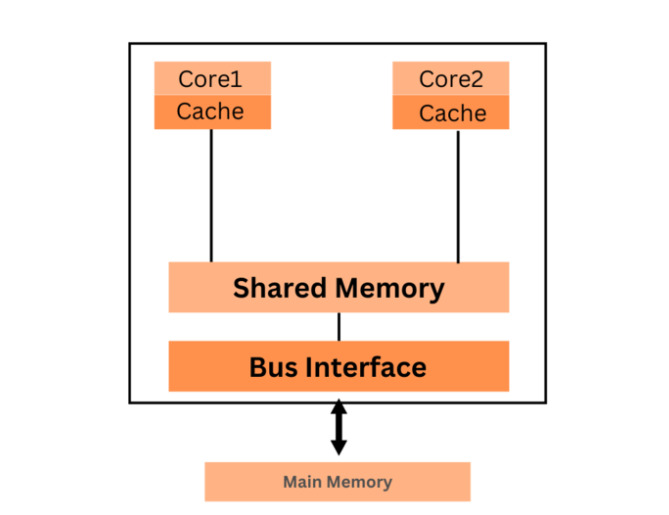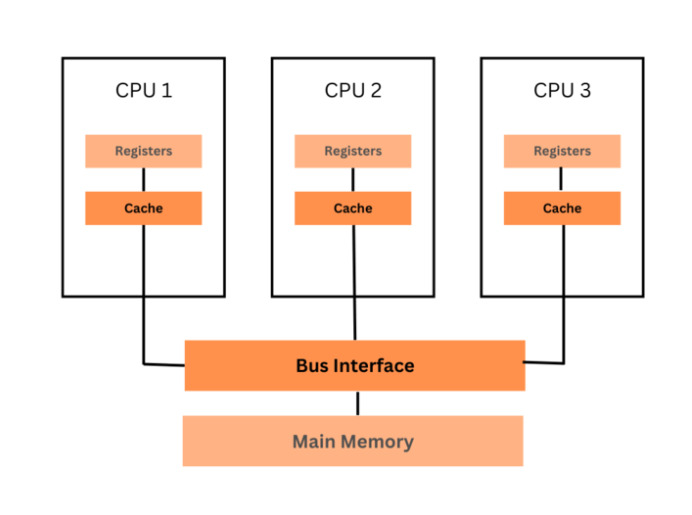
 Data Structure
Data Structure Networking
Networking RDBMS
RDBMS Operating System
Operating System Java
Java MS Excel
MS Excel iOS
iOS HTML
HTML CSS
CSS Android
Android Python
Python C Programming
C Programming C++
C++ C#
C# MongoDB
MongoDB MySQL
MySQL Javascript
Javascript PHP
PHP
- Selected Reading
- UPSC IAS Exams Notes
- Developer's Best Practices
- Questions and Answers
- Effective Resume Writing
- HR Interview Questions
- Computer Glossary
- Who is Who
Multiprocessor and Multicore Organization
There are two methods for creating systems of computers with multiple processors or processor cores: multiprocessor organization and multicore organization. Both strategies aim to boost a computer's processing power by enabling it to handle several tasks at once.
Several separate processors linked by a communication network make up a multiprocessor system in most cases. Each processor can carry out a unique set of instructions and has a separate local memory. The throughput of the entire system can be increased by these processors working on several tasks concurrently.
In this article, we will explore Multiprocessor and Multicore Organization, their use cases, examples in Python, and their benefits and drawbacks of each as well.
What is a Multiprocessor System?
A system with a multiprocessor has several CPUs or processors. These systems execute multiple instructions concurrently. Throughput improves as a result. The remaining CPUs will keep operating normally even if one CPU fails. Multiprocessors are therefore more dependable.
Multiprocessor systems can take advantage of distributed or shared memory. To execute instructions concurrently, each processor in a shared memory multiprocessor shares the main memory and peripherals. In these systems, the main memory is accessed by all CPUs via a single bus. As bus traffic increases, the majority of CPUs will be inactive. The symmetric multiprocessor is another name for this kind of multiprocessor. It gives each CPU access to a single memory region.
A distributed memory multiprocessor contains private memory for each CPU. To do the computational duties, all processors can use local data. If remote data is required, the processor may access the main memory or interact with other processors over the bus.

Use Cases of Multiprocessor Organization
Let us now discuss some of the use cases of Multiprocessor Organization.
High-performance computing clusters ? Multiprocessor systems are used in clusters to distribute computational tasks among multiple processors, enabling high-performance computing for scientific simulations, weather forecasting, and financial modeling.
Database management systems ? Multiprocessor systems are utilized in database servers to handle concurrent user requests and provide efficient data processing and retrieval.
Web servers? Multiprocessor systems are employed in web servers to handle a large number of simultaneous client connections and deliver fast response times.
Virtualization and cloud computing ? Multiprocessor systems are used in virtualized environments and cloud computing platforms to provide scalable and efficient computing resources for multiple virtual machines or containers.
Real-time systems ? Multiprocessor systems are used in real-time applications, such as flight control systems and process control systems, to ensure a timely and predictable response to critical events.
Example
Let us explore an example in Java for Multiprocessor Organization in Java below.
In this example, a ThreadPoolExecutor is created with four threads, representing a multiprocessor system. Ten tasks are submitted to the executor service, and each task is executed concurrently on one of the available threads. The output shows the execution of each task along with the name of the processor (thread).
import java.util.concurrent.ExecutorService;
import java.util.concurrent.Executors;
public class MultiprocessorExample {
public static void main(String[] args) {
ExecutorService executorService = Executors.newFixedThreadPool(4);
for (int i = 0; i < 10; i++) {
final int taskId = i;
executorService.execute(() -> {
System.out.println("Executing task: " + taskId + " on processor: " + Thread.currentThread().getName());
});
}
executorService.shutdown();
}
}
Output
Executing task: 0 on processor: pool-1-thread-1 Executing task: 1 on processor: pool-1-thread-2 Executing task: 2 on processor: pool-1-thread-3
Benefits of Multiprocessor System
Over a single processor system, a multiprocessor system has a number of benefits, such as?
A multiprocessor system's processing power increases significantly because more tasks may be carried out simultaneously by more processors working in parallel.
A multiprocessor system's greater processing capability makes it possible to process huge amounts of data more effectively, which boosts system throughput.
Workloads can be distributed more evenly among several processors in a multiprocessor system, maximizing the usage of system resources.
By enabling work to be automatically moved to other processors in the case of a failure, a multiprocessor system can provide fault tolerance.
Drawbacks of the Multiprocessor System
While a multiprocessor system has some benefits over just one processor system, there are some drawbacks to take into account as well ?
A multiprocessor system's design and implementation are more difficult than those of one processor system.
Task synchronization and coordination across numerous processors can be difficult, especially when using shared resources.
Performance may be impacted by the extra communication and synchronization overhead that systems with multiple processors may experience.
What is a Multicore System?
A multi-core processor is a single computing device with many cores (separate processing units). It indicates that the system has a single CPU with several cores. These cores can each read and execute instructions from a computer. Despite being cores rather than processors, they function in a way that gives the impression that the computer system has multiple processors. These cores can carry out regular processor operations like a branch, move data, and add data.
A multicore system allows a single processor to execute many instructions at once, boosting the system's total program execution performance. It increases the speed at which instructions are carried out while reducing the amount of heat produced by the CPU. Applications for multicore processors include general-purpose, embedded, network, and graphics processing (GPU).

Use Cases of Multicore Organization
Let us now discuss some of the use cases of Multicore Organization.
Personal computers and laptops? Multicore systems are commonly used in personal computers and laptops to provide improved performance for everyday computing tasks, such as web browsing, document processing, and multimedia playback.
Mobile devices? Multicore systems are employed in smartphones and tablets to enable smooth multitasking, fast app switching, and efficient execution of resource-intensive applications, including gaming and video editing.
Embedded systems? Multicore systems find applications in embedded systems, such as automotive systems, medical devices, and consumer electronics, to handle multiple tasks concurrently while meeting real-time constraints.
Data analytics and machine learning? Multicore systems are utilized in data analytics and machine learning platforms to accelerate the processing of large datasets and complex algorithms, improving performance and reducing training times.
Server virtualization? Multicore systems are used in server virtualization environments to enhance the efficiency and scalability of virtual machines, allowing for better resource utilization and consolidation.
Example
Here's an example of utilizing multiple cores in Python.
import multiprocessing
# Function to be executed by each core
def core_function(core_id):
print("Executing task on core", core_id)
# Get the number of CPU cores
num_cores = multiprocessing.cpu_count()
# Create a process pool with all CPU cores
pool = multiprocessing.Pool(processes=num_cores)
# Submit tasks to the process pool
for core_id in range(num_cores):
pool.apply_async(core_function, args=(core_id,))
# Close the pool and wait for all tasks to complete
pool.close()
pool.join()
Output
Executing task on core 0 Executing task on core 1 Executing task on core 2 Executing task on core 3
In this example, the code utilizes the multiprocessing module in Python. It determines the number of CPU cores available using the cpu_count() function. Then, it creates a process pool with all the CPU cores using the Pool class from multiprocessing. Each core executes the core function with its assigned core ID. The output displays the execution of the function on each core.
Benefits of Multicore System
Compared to a single-core system, a multicore system has a number of benefits, such as?
A multicore system's processing capability is considerably increased by its ability to carry out numerous tasks concurrently.
By enabling more effective system resource use and removing bottlenecks, multicore systems can boost performance.
A multicore system can operate tasks more effectively and use less power than a single-core system by dividing workloads over numerous cores.
Multiple applications and processes can run simultaneously on multicore systems, improving user experience.
Drawbacks of Multicore System
Multicore systems have a number of benefits, but there are also certain drawbacks to take into account, such as ?
Software development for systems with multiple processors can be more difficult than for single-core systems since programmers must make sure their code can utilize many cores and effectively handle shared resources.
Older software that wasn't created for multicore systems may cause compatibility problems and poor performance.
Cache coherency must be preserved when several cores reference the same memory location in order to guarantee that every core has access to the most recent data. Performance may suffer as a result of higher overhead.
Conclusion
Two distinct strategies for boosting processing capability in computer systems are multiprocessor and multicore organizations. Multicore systems accomplish the same task using many cores within a single processor, whereas multiprocessor systems use multiple processors to carry out tasks simultaneously.

